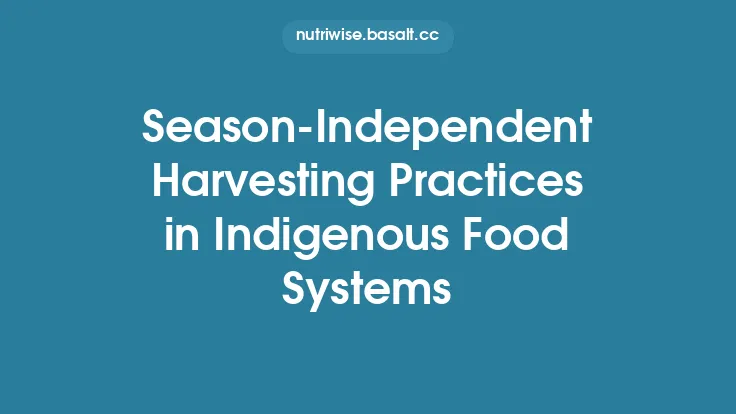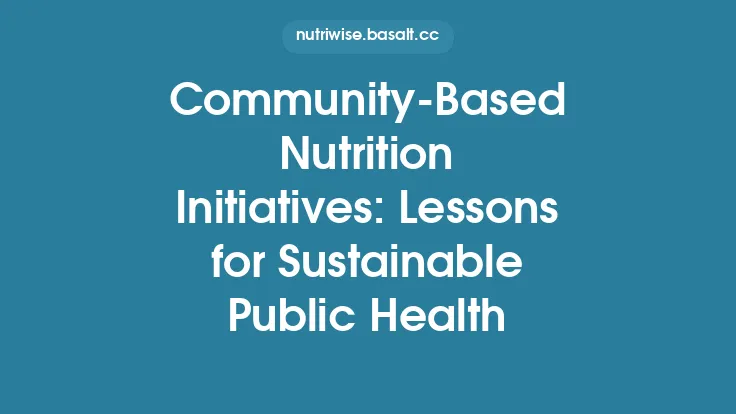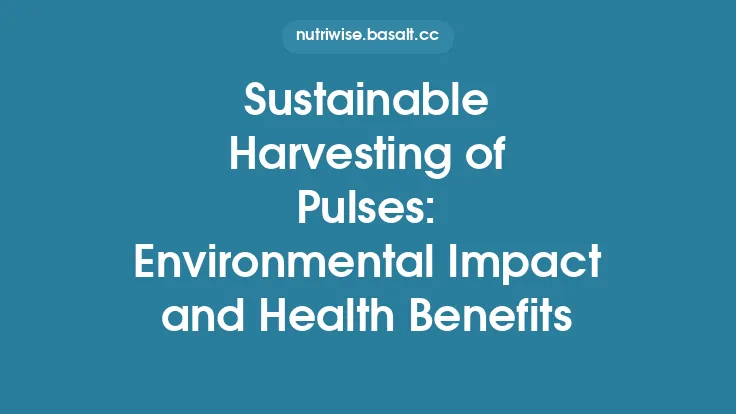Indigenous food systems have long been rooted in a deep, reciprocal relationship between people and the environments that sustain them. Long before the advent of industrial agriculture, Indigenous communities cultivated, gathered, and managed a mosaic of resources that together formed a resilient, nutritionally complete diet. This foundation rests on an intricate web of ecological knowledge, cultural practices, and social structures that together ensure the continuity of food availability, quality, and health benefits across generations. Understanding these underlying principles offers valuable insights into how sustainable nutrition can be achieved without compromising ecological integrity.
Historical Roots of Indigenous Food Systems
The origins of Indigenous food systems are intertwined with the migration patterns, settlement strategies, and spiritual worldviews of each community. Early groups adapted to diverse biomes—coastal zones, temperate forests, arid deserts, and high‑altitude plateaus—by developing region‑specific subsistence strategies. These strategies were not static; they evolved through trial, observation, and intergenerational transmission, resulting in a dynamic repertoire of practices that balanced immediate needs with long‑term ecosystem health.
Key historical elements include:
- Territorial Stewardship: Land was viewed as a living entity, with stewardship responsibilities embedded in cultural narratives and legal frameworks. This perspective fostered practices that maintained soil fertility, water quality, and biodiversity.
- Mobility and Seasonal Rounds: Many societies organized their movements around seasonal resource peaks, ensuring that no single area was overexploited. This mobility also facilitated the exchange of seeds, techniques, and culinary knowledge across regions.
- Reciprocal Exchange Networks: Trade and gift‑giving among neighboring groups created a safety net that diversified diets and spread risk, reinforcing social cohesion while expanding nutritional options.
Ecological Principles Underpinning Sustainable Nutrition
Indigenous food systems are built upon a set of ecological principles that align human nutrition with ecosystem function:
- Diversity as a Buffer: Polyculture—growing multiple species together—reduces pest pressure, improves pollinator support, and stabilizes yields. Diverse plant assemblages also provide a broader spectrum of macro‑ and micronutrients.
- Closed Nutrient Loops: Organic waste, such as plant residues, animal by‑products, and human excreta, is routinely reintegrated into the soil through composting, pit latrines, or controlled burns, maintaining soil organic matter and nutrient availability.
- Successional Management: By mimicking natural succession, Indigenous cultivators create layered canopies that maximize light capture, protect soil from erosion, and support a range of edible species at different growth stages.
- Water Harvesting and Conservation: Techniques such as swales, check dams, and terracing capture runoff, recharge aquifers, and provide reliable irrigation without depleting water sources.
These principles collectively ensure that food production does not exceed the regenerative capacity of the environment, thereby sustaining nutritional quality over centuries.
Land and Water Stewardship Practices
Soil Health Management
- Mulching and Ground Cover: Indigenous gardeners often retain leaf litter, straw, or living groundcovers to suppress weeds, moderate soil temperature, and retain moisture. This practice also encourages beneficial soil microbes, such as mycorrhizal fungi, which enhance nutrient uptake.
- Biochar Integration: In some fire‑prone regions, charcoal produced from controlled burns is mixed into soils, improving cation exchange capacity and sequestering carbon.
- Rotational Fallow: Periodic resting of fields allows natural regeneration of soil biota and reduces pathogen buildup.
Water Resource Governance
- Rainwater Capture: Earthen cisterns, stone-lined ponds, and woven reed baskets collect and store precipitation for use during dry periods.
- Riparian Buffer Zones: Planting native vegetation along waterways filters sediments, stabilizes banks, and provides habitat for fish and amphibians that are integral to the diet.
- Seasonal Floodplain Utilization: Flood-tolerant crops are sown in low‑lying areas that receive nutrient‑rich silt during seasonal floods, reducing the need for external fertilization.
Diverse Production Strategies: Polyculture and Agroforestry
Indigenous agroforestry systems blend trees, shrubs, vines, and herbaceous crops into a single productive unit. This integration yields multiple benefits:
- Vertical Stratification: Tall canopy trees (e.g., nut‑bearing species) provide shade and windbreaks, while understory layers supply edible greens, tubers, and medicinal herbs.
- Nitrogen Fixation: Leguminous trees and shrubs enrich the soil with biologically available nitrogen, reducing reliance on external inputs.
- Habitat Creation: The structural complexity supports pollinators, seed dispersers, and natural pest predators, creating a self‑regulating ecosystem.
Polyculture plots often incorporate companion planting principles, where certain species enhance each other’s growth or deter pests through allelopathic compounds. For example, planting aromatic herbs alongside root crops can reduce nematode infestations without chemical interventions.
Seasonal Rhythm and Food Availability
Indigenous calendars are intimately linked to phenological cues—flowering, fruiting, migration, and weather patterns. By aligning agricultural activities with these cues, communities achieve:
- Optimized Harvest Timing: Harvesting at peak nutritional content (e.g., before seed dispersal) maximizes vitamin and mineral concentrations.
- Staggered Food Flow: Overlapping harvest windows from different species smooth out food supply, preventing periods of scarcity.
- Cultural Ceremonies: Seasonal festivals often coincide with key harvests, reinforcing communal bonds and collective responsibility for resource management.
Community-Based Harvesting and Distribution
Food acquisition is rarely an individual endeavor; it is embedded within communal frameworks that ensure equitable access:
- Collective Foraging Zones: Designated areas are managed by community committees that monitor harvest levels, enforce quotas, and rotate usage to prevent depletion.
- Shared Storage Facilities: Communal granaries, root cellars, and smokehouses enable bulk preservation, reducing post‑harvest loss and providing a buffer against environmental shocks.
- Redistributive Practices: Surpluses are redistributed through potlatch‑type ceremonies, gifting, or communal meals, reinforcing social cohesion and mitigating food insecurity.
These mechanisms embody a principle of “food as a shared resource,” which contrasts sharply with market‑driven commodity models.
Food Processing, Preservation, and Culinary Techniques
Indigenous culinary knowledge transforms raw ingredients into nutritionally dense, safe, and palatable foods through a variety of low‑tech methods:
- Fermentation: Lactic acid fermentation of tubers, leafy greens, and fish not only extends shelf life but also enhances bioavailability of nutrients such as B‑vitamins and minerals.
- Drying and Smoking: Sun‑drying, air‑curing, and low‑temperature smoking reduce moisture content, inhibit microbial growth, and concentrate flavors.
- Stone‑Boiling and Earth Ovens: These cooking methods allow for gentle, even heat distribution, preserving heat‑sensitive nutrients while breaking down anti‑nutritional factors (e.g., phytic acid in certain seeds).
- Nixtamalization‑Like Processes: Soaking and cooking certain grains or legumes in alkaline solutions improves protein digestibility and releases bound minerals.
These techniques are adapted to local climate conditions and resource availability, ensuring that food remains safe and nutritious throughout the year.
Nutritional Balance Through Whole Food Synergy
Rather than focusing on isolated nutrients, Indigenous diets achieve balance through the synergistic interaction of whole foods:
- Complementary Amino Acid Profiles: Combining legumes with cereals or nuts provides a complete set of essential amino acids without reliance on animal protein.
- Micronutrient Pairing: Consuming vitamin‑C‑rich fruits alongside iron‑rich greens enhances non‑heme iron absorption, mitigating anemia risk.
- Fiber and Fat Integration: High‑fiber plant foods paired with modest amounts of animal or seed fats improve satiety, regulate glycemic response, and support gut microbiota diversity.
This holistic approach to nutrition reflects an intuitive understanding of how foods interact within the body, a knowledge base refined over millennia.
Resilience to Climate Variability
Indigenous food systems are inherently adaptable to climatic fluctuations due to several built‑in safeguards:
- Genetic Diversity: Maintaining multiple landraces and wild relatives preserves traits such as drought tolerance, heat resistance, and pest resilience.
- Decentralized Production: Small, dispersed plots reduce the risk of total crop failure from localized extreme events.
- Dynamic Management: Real‑time observation of weather patterns informs immediate adjustments—e.g., shifting planting dates, altering irrigation, or temporarily intensifying foraging in less‑affected zones.
These strategies provide a template for building climate‑smart food systems that can withstand the increasing volatility associated with global climate change.
Transmission of Knowledge and Cultural Continuity
The perpetuation of sustainable nutrition hinges on robust knowledge transmission mechanisms:
- Oral Traditions and Storytelling: Myths, songs, and narratives encode ecological information, seasonal calendars, and ethical guidelines for resource use.
- Apprenticeship Models: Youth learn by participating in planting, harvesting, and processing alongside elders, ensuring skill acquisition through practice.
- Ritualized Learning Spaces: Ceremonial gatherings often include demonstrations of food preparation, reinforcing both technical skills and cultural values.
By embedding nutritional wisdom within cultural identity, Indigenous communities safeguard both health and heritage.
Contemporary Relevance and Lessons for Global Food Systems
While rooted in specific cultural contexts, the foundational principles of Indigenous food systems offer universal lessons for achieving sustainable nutrition at scale:
- Emphasize Diversity: Agricultural policies should promote polyculture and agroforestry to enhance ecosystem services and dietary variety.
- Close Nutrient Loops: Waste recycling and organic amendment practices can reduce dependence on synthetic fertilizers and improve soil health.
- Integrate Community Governance: Decentralized, participatory management of food resources can increase resilience and equity.
- Prioritize Knowledge Co‑Creation: Engaging Indigenous knowledge holders in research and policy development ensures that solutions are context‑appropriate and culturally respectful.
Adopting these insights can help transition modern food systems toward models that nourish both people and the planet, honoring the time‑tested wisdom embedded in Indigenous food systems.





